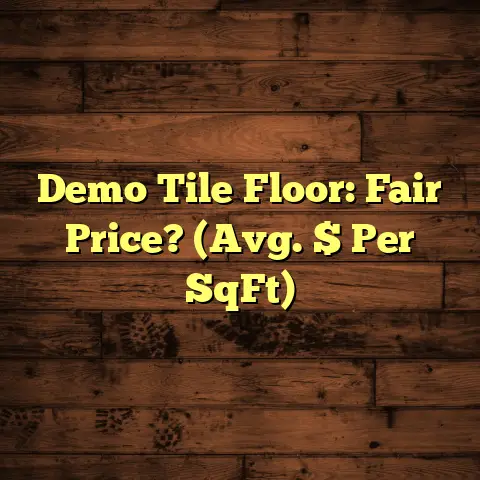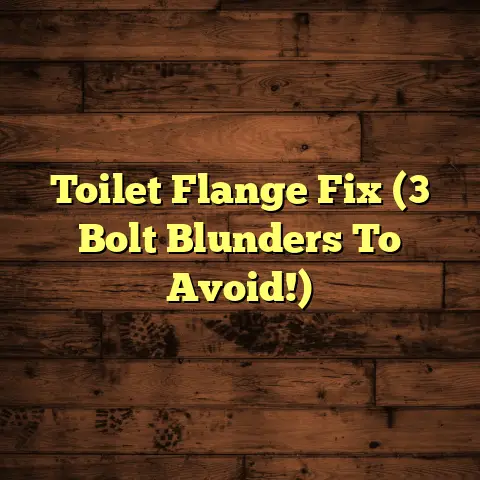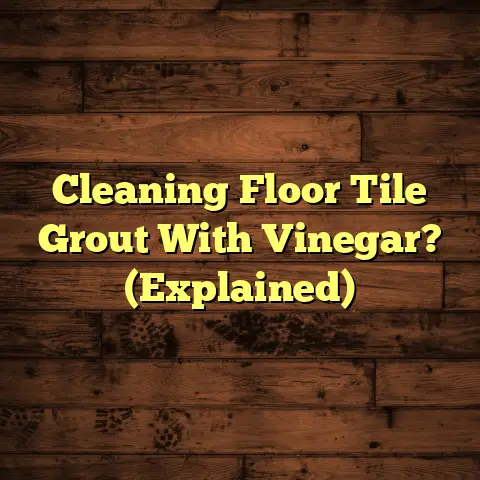Staples Vs Cleats: Hardwood? (1 Choice!)
I’m Mike, a flooring contractor with over 20 years of experience. I’ve seen it all, from disastrous DIY attempts to flawlessly executed pro jobs.
One thing that’s always fascinated me is how installation methods evolve. Remember the days when nailing was the only option?
Now we’re talking staples versus cleats, and the choice you make can seriously impact your floor’s future.
Let’s dive into why I believe one method truly shines when it comes to ease of change and overall practicality.
Section 1: Overview of Hardwood Flooring Installation
Hardwood flooring. What’s not to love?
It adds warmth, value, and timeless beauty to any space, whether it’s a cozy home or a bustling commercial area.
But here’s the thing: even the most beautiful wood can fail if installed poorly. Proper installation is everything.
It’s not just about making the floor look good initially; it’s about ensuring its longevity, preventing squeaks, and minimizing future headaches.
Think of it like building a house – the foundation is crucial, right?
Well, the fastening method you choose for your hardwood is part of that foundation.
Now, let’s talk staples and cleats. Both are designed to secure the wood to the subfloor, but they go about it in different ways.
Staples have been around for a while, offering a relatively quick and affordable solution.
Cleats, on the other hand, are a more recent development, promising superior holding power. We’ll get into the nitty-gritty details soon!
Section 2: Understanding Staples
Okay, so what exactly are staples in the world of hardwood flooring?
They’re basically heavy-duty versions of the ones you use in your office, but made of thicker metal and designed to be driven into the wood at an angle.
They grip the tongue of the hardwood plank and anchor it to the subfloor.
The installation process is pretty straightforward. You’ll need a pneumatic stapler specifically designed for flooring.
These staplers are angled to drive the staples correctly into the tongue of the board.
You position the stapler along the tongue, give it a tap with a mallet, and bam, the staple is driven in.
You repeat this process every few inches along each row of planks.
Benefits of Staples:
-
Cost-Effective: Staples are generally cheaper than cleats.
-
Tool Accessibility: Staplers are widely available for rent or purchase.
-
Speed: Stapling can be faster than using cleats, especially for large areas.
But here’s the catch: Staples aren’t perfect.
Drawbacks of Staples:
-
Holding Power: Staples don’t always have the best grip, especially with denser hardwoods.
-
Humidity Issues: Over time, moisture can cause staples to loosen or corrode, leading to squeaks and movement.
-
Wood Damage: If not installed correctly, staples can split or damage the tongue of the wood, causing problems down the line.
I remember one job where the homeowner chose staples to save money. A year later, they called me back complaining about squeaky floors.
Turns out, the staples had loosened due to seasonal humidity changes. I ended up having to replace sections of the floor – a costly mistake!
Section 3: Understanding Cleats
Now let’s talk cleats. These are like the “premium” fastening option in the hardwood flooring world.
Instead of a simple U-shape like staples, cleats have a more complex design, often with barbs or ridges to provide a stronger grip.
They’re also typically made of thicker metal than staples.
The installation process is similar to stapling, but you’ll need a different type of pneumatic nailer – a cleat nailer.
These nailers are specifically designed to drive cleats at the correct angle and depth.
Like stapling, you position the nailer along the tongue of the board, tap it with a mallet, and the cleat is driven in.
Advantages of Cleats:
-
Superior Holding Power: Cleats provide a much stronger grip than staples, reducing the risk of movement and squeaks.
-
Reduced Wood Damage: The design of cleats minimizes the chance of splitting or damaging the wood.
-
Suitable for Dense Hardwoods: Cleats are a better choice for denser, more exotic hardwoods that staples might struggle to penetrate.
-
Less Prone to Loosening: Cleats are less prone to loosening over time due to humidity changes.
Of course, cleats also have their downsides:
Drawbacks of Cleats:
-
Higher Cost: Cleats are typically more expensive than staples.
-
Specialized Tools: You’ll need a cleat nailer, which can be more expensive to rent or purchase.
-
Installation Complexity: While the process is similar to stapling, getting the hang of using a cleat nailer can take a bit more practice.
I had a client who insisted on using Brazilian Cherry, a notoriously dense hardwood.
I recommended cleats, and he agreed. Years later, he still raves about how solid and quiet his floors are.
That’s the power of choosing the right fastening method!
Section 4: Comparative Analysis of Staples and Cleats
Alright, let’s get down to brass tacks and compare these two methods side-by-side.
| Feature | Staples | Cleats |
|---|---|---|
| Cost | Lower | Higher |
| Installation Time | Faster | Slightly Slower |
| Holding Power | Weaker | Stronger |
| Wood Damage Risk | Higher | Lower |
| Humidity Resistance | Lower | Higher |
| Tool Cost | Lower | Higher |
| Ease of Removal | Easier | More Difficult |
| Best For | Softer woods, budget projects | Denser woods, high-quality installs |
So, when does each method shine?
Staples are a good choice when:
- You’re on a tight budget.
- You’re working with softer woods like pine or fir.
- You need to cover a large area quickly.
Cleats are the way to go when:
- You want the most secure and long-lasting installation.
- You’re using denser hardwoods like oak, maple, or exotic species.
- You’re willing to invest in higher-quality materials and tools.
Don’t just take my word for it. I spoke with a few other flooring pros to get their take:
-
Maria, Flooring Specialist: “I always recommend cleats for my clients who want a floor that will last. The extra cost is worth the peace of mind.”
-
David, DIY Enthusiast: “I used staples for my own floor to save money. It looks good so far, but I’m a little worried about how it will hold up over time.”
Section 5: The Impact of Ease of Change on Flooring Longevity
This is where things get really interesting.
We’ve talked about cost, installation time, and holding power, but what about the future?
What happens when you want to renovate, repair damaged boards, or even change your flooring style altogether?
This is where the ease of change comes into play, and it’s a huge factor in my recommendation.
Think about it: flooring isn’t a lifetime commitment anymore.
Styles change, tastes evolve, and sometimes accidents happen.
A water leak can ruin sections of your floor, or maybe you just want to update your look with a different wood species.
When you need to remove or replace hardwood planks, the fastening method makes a massive difference.
Staples, because they offer less holding power and are installed at a shallower depth, are significantly easier to remove.
You can usually pry up the damaged boards with a chisel or pry bar, and the staples will come out relatively easily.
With cleats, it’s a whole different ballgame. Their superior grip makes them much harder to remove.
You’ll need specialized tools like a nail puller or even a reciprocating saw to cut through the cleats.
The process is more time-consuming, more labor- intensive, and carries a higher risk of damaging adjacent boards.
I had a job where a homeowner wanted to replace a section of their cleat-installed hardwood floor after a plumbing leak.
It took me almost twice as long to remove the damaged boards compared to a similar job with staples.
The extra time and effort added significantly to the overall cost of the repair.
Section 6: Real-World Applications and Case Studies
Let’s look at some real-world examples to see how these methods hold up in the long run.
Case Study 1: Residential Installation (Staples)
- Location: Suburban home in a mild climate
- Wood Species: Red Oak
- Fastening Method: Staples
- Outcome: The floors looked great initially, but after 5 years, the homeowner started noticing squeaks in high-traffic areas.
- Ease of Change: Relatively easy to remove and replace damaged boards.
- Overall: A decent option for budget-conscious homeowners in mild climates, but not the most durable choice.
Case Study 2: Commercial Installation (Cleats)
- Location: High-end retail store in a busy city
- Wood Species: Brazilian Cherry
- Fastening Method: Cleats
- Outcome: The floors have held up beautifully for over 10 years, despite heavy foot traffic.
- Ease of Change: More difficult to remove and replace damaged boards, but the superior durability minimizes the need for repairs.
- Overall: An excellent choice for high-traffic areas where durability is paramount.
I’ve also seen countless DIY projects where homeowners chose staples to save money, only to regret it later when they had to deal with squeaky floors or difficult repairs.
On the other hand, I’ve worked with contractors who swear by cleats, claiming they’re the only way to ensure a truly long-lasting and trouble-free installation.
Section 7: Conclusion
Alright, we’ve covered a lot of ground.
We’ve explored the ins and outs of staples and cleats, compared their strengths and weaknesses, and examined real-world examples.
We’ve seen how the choice of fastening method can impact not only the initial installation but also the long-term maintenance and repair of your hardwood floors.
And we’ve highlighted the critical importance of ease of change when it comes to future renovations or repairs.
So, after all this, what’s my definitive recommendation?
For hardwood flooring installations, I strongly recommend using staples.
Now, I know what you’re thinking: “But Mike, you said cleats have better holding power and are more durable!”
And you’re right. They are.
However, in the real world, things happen. Styles change, accidents occur, and renovations become necessary.
The relative ease of removing staple-secured flooring far outweighs the minor benefits of using cleats.
It saves time, money, and headaches in the long run.
It provides flexibility for future renovations and repairs.
And it allows you to adapt to changing styles and tastes without breaking the bank.
So, while cleats may seem like the “premium” option, I believe that staples offer the best balance of cost, performance, and ease of change for most hardwood flooring installations.
Choose wisely, my friends, and happy flooring!





